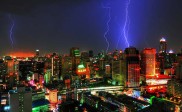Tips for Better Architectural Photography
The art of architectural photography
Most architectural buildings and structures have a very specific function: habitation, work places, religious buildings, etc. They are characteristic of a particular style, historic period or a human environment. You will have to examine the structure or building you intend to photograph thoroughly in order to be able to focus on one of its functions.
The first thing to do when shooting an architectural structure is to determine its most normal aspect. Then, turn around the place and explore the less known characteristics of your subject. Try to find an unusual and impressive point of view. Use the weather for your benefit. Take shots of the building under rain or in a snowy or foggy weather.

Bert Kaufmann
There are many other ways to add interest in an architectural image. You can capture the reflection of a building in a mirror or in a puddle. You can also use an element in the foreground to frame the building or structure you are shooting.
Perspective & Point of View:
High buildings may cause some problems. In most cases, you will need to take the photo from a low angle of view which will make the vertical lines converge. The converging lines effect is acceptable and even desirable when your intention is to capture the vertiginous height of a building. But it can be a bit annoying when it comes to buildings of normal height. In order to get rid of this converging lines effect, you will need to step back and put the building in the center of your composition. But by taking the photo from a far away distance you run the threat of loosing details. To avoid such a loss, use small apertures to get the maximum depth of field and a tripod to avoid camera shake, as you will be taking longer exposure with the small apertures. In case you can’t take the photo from far away and you need your verticals to be straight, you will have to resort to the use of a perspective control lens (tilt-shift lens) to correct this perspective problem. This kind of lens permits the movement of the lens while keeping the camera body parallel to the ground.
Creating an Atmosphere:
The appearance of a building changes according to the light, weather and seasons.
A photo of an old castle or some ruins in a stormy weather will give the impression of a medieval atmosphere. In the same logic a photo of a building silhouetted by the warm tones of a setting sun can convey a calm and peaceful atmosphere.
Also, lighting is very important in creating the feeling channeled by a photo. In the above picture the warm tone of the sky, created by the setting sun, helps in communicating the serene and peaceful atmosphere already present because of the mosque and the pigeons.
Light can help in focusing on the details and textures of a building. For this purpose, light hitting a building from the side is the best, as it will create parts that are lit up and other parts that are totally in shadow. This can create some interesting abstract patterns.
Besides light and weather, composition and point of view play a great role in contributing to the atmosphere of an architectural photo. Choosing to include or exclude something from the frame can change the final impact of an image. You can include the environment of a building in your composition to make it easier to put the photo in a context. Also, adding a human element in the frame gives interest to an architectural image. You can use people either to show the huge size of a building or to add a sentimental value to the composition.
Details:
A small part of a building, a detail of a sculptured decoration or a wall full of cracks can sometimes be more interesting to photograph than a whole building.
Details like textures, lines or volumes give the viewer precise information about how the structure or the building was conceived. These details will tell us things like whether a particular building follows a gothic style or is built following modern standards.
Photos of architectural details are usually a part of whole set of photos constituting together a body describing the building being photographed. When taking photos of details, think of composing them in way that they don’t depend on the other images to convey a meaning.
Some Examples of Architectural Photography:
Cityscapes & Skylines:

Architecture by ChoudhrySaab
Cityscapes and skylines give a general view over the architecture of a city. When taking this kind of photos, the first thing to do is to find a location. Look for high spots where you are more likely to get uninterrupted views of the city. The second thing to consider is the light. Don’t just take a photo in the middle of the day and get going to other things. Try different times of the day. Some of the best photos of skylines can be taken moments before or after sunset. You can also take some night shots. Lit up window can produce an interesting pattern.
Famous Buildings:

Architecture by smlp.co.uk
It’s only a natural thing to want to take photos of famous buildings. But, what makes the difference between a regular tourist and a devoted architectural photographer is the way they take the picture. Look at the famous building from every possible angle and try to find a composition and a point of view that are hard for others to notice. Find an element to frame the building, for instance.
Interiors:

Architecture Photography by Jeremy Levine Design
Photographing interiors can be difficult because of some limitations, like the quantity of available light or the small space. Depending of what you want to convey , you can use natural light or artificial lighting.
If you want your interior shot to show every detail in a room, then you will need artificial lighting. You can use flashes or continuous light, but try always to bounce your light on a reflecting surface to get a diffused light that is not harsh. In interiors like churches and cathedrals, natural lighting is more suitable. The photographer is usually after capturing the atmosphere in such settings. In that case the use of a tripod is recommended as you will be using relatively long exposures.
You may want to take a look at 30 Impressive Examples of Architecture Photography







Always a pleasure to read your articles. keep it up